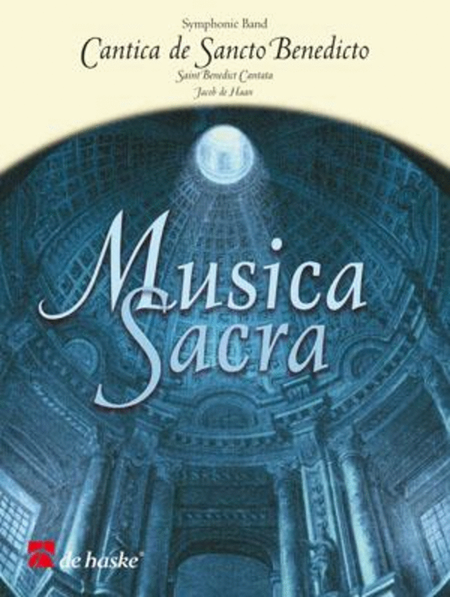Cantica de Sancto Benedicto
Saint Benedict Cantata
-
Ships in 2 to 3 weeks
Details
Description
SKU: BT.DHP-1074334-140
Saint Benedict Cantata. Composed by Jacob De Haan. Musica Sacra. Score Only. Composed 2008. De Haske Publications #DHP 1074334-140. Published by De Haske Publications (BT.DHP-1074334-140).9x12 inches. English-German-French-Dutch.
Cantica de Sancto Benedicto is a three-movement work for mixed choir, soprano solo, concert band and organ ad libitum - on Latin lyrics that relate to the life of Saint Benedict. It was commissioned by the city of Norcia in Italy, whereBenedict was born. The holy Benedict (480-547) is considered the founder of monastic life within the Roman Catholic Church. His enormous influence is especially owing to his monastic rule, the Regula Benedicti.Jacob de Haan has named the movements ofCantica de Sancto Benedicto after the Holy Trinity: the Father (Gloria Patri), the Son (Gloria Filio) and the Holy Spirit (Gloria Spiritui Sancto). The lyrics of thehymn Gemma Caelestis, (which, like the othertexts, were originally used in Gregorian chant) are voiced by the choir. To this purpose, Jacob de Haan composed new, choral-like, homophone music. The sequence Laeta Quies is rendered by the soprano; the verses (divided over the threemovements) are alternated with those of Gemma Caelestis. The work closes with an impressive grand finale, in which texts are used from the proprium of the mass in honor of the saint’s day of the holy Benedict (11 July). Notes to the conductor:For this cantata, there are various possibilities for the performance. The first involves a performance in which the choir and soprano parts are only accompanied by organ. Such a performance has several advantages: since the band never soundstogether with the choir and the soprano, no balance problems occur, and even a performance with a large concert band and a small cantata choir is conceivable. A special layout is also possible - with which you can set up a three-dimensionalperformance in a church. For example, the choir can sing in the chancel, accompanied by the choir organ; the soprano can stand on the gallery, accompanied by the main organ; and the band can be seated in another part of the church. The choir couldalso sing from a gallery. With layouts like this, working with two conductors is advisable. Choral parts available separately.
Koorpartijen apart verkrijgbaar.
Cantica de Sancto Benedicto ist ein dreisätziges Werk für gemischten Chor, Sopran-Solist, sinfonisches Blasorchester und Orgel ad lib. - zu lateinischen Texten über das Leben des Heiligen Benedikt. Es entstand im Auftrag der italienschen StadtNursia, dem Geburtsort von Benedikt. Jacob de Haan benannte die Sätze von Cantica de Sancto Benedicto nach der Heiligen Dreifaltigkeit: der Vater (Gloria Patri), der Sohn (Gloria Filio) und der Heilige Geist (Gloria SpirituiSancto). Der Text zur Hymne Gemma Caelestis (der wie die übrigen Texte ursprünglich aus dem Gregorianischen Choral stammt) wird vom Chor gesungen. Zu diesem Zweck komponierteJacob de Haan neue choralartige, homophone Musik. Der AbschnittLaeta Quies wird vom Sopran vorgetragen; die Strophen (die sich über alle drei Sätze verteilen) wechseln sich mit denen von Gemma Caelestis ab. Das Werk endet mit einem eindrucksvollen großartigen Finale, in dem Texte aus dem Propriumaus der Messe zu Ehren des Feiertags des Heiligen Benedikt (11. Juli) verwendet werden. Chorstimmen separat erhältlich.
Cantica de Sancto Benedicto (Cantate de saint Benoît) est une œuvre en trois mouvements pour Soprano, Chœur mixte, Orchestre d’Harmonie et Orgue (ad lib.). Basée sur des textes en latin relatant la vie de saint Benoît, cettecantate est une œuvre de commande pour la ville de Nursie en Italie, ville natale du moine.Benoît de Nursie ou saint Benoît (vers 480-547) est considéré comme l’initiateur de la vie monastique dans l’Église catholique romaine. Son immenseinfluence est essentiellement liée la rédaction d’une règle de vie : la Règle monastique de saint Benoît (Regula Benedicti).Jacob de Haan a choisi de donner le nom des troispersonnes de la Sainte-Trinité aux trois mouvements de l’œuvre: le Père (Gloria Patri/ Gloire au Père), le Fils (Gloria Filio/ Gloire au Fils) et le Saint-Esprit (Gloria Spiritui Sancto/ Gloire au Saint-Esprit).Le texte de l’hymne Gemma Caelestis (utilisé dans le chant grégorien l’instar des autres textes) est chanté par le Chœur sur une musique de nature homophonique laquelle le compositeur a donné un style choral. La séquence Laeta Quies est chantée par la Soprano. La prose de la séquence est répartie sur lestrois mouvements en alternance avec le texte de l’hymne latine. Le finale de l’œuvre est impressionnant. Il développe des textes du Propre de la Messe en l’honneur de la Saint-Benoît, célébrée le 11 juillet. Partitions pour chœur disponibles séparément.
Parti per coro disponibili a parte.

 Share
Share